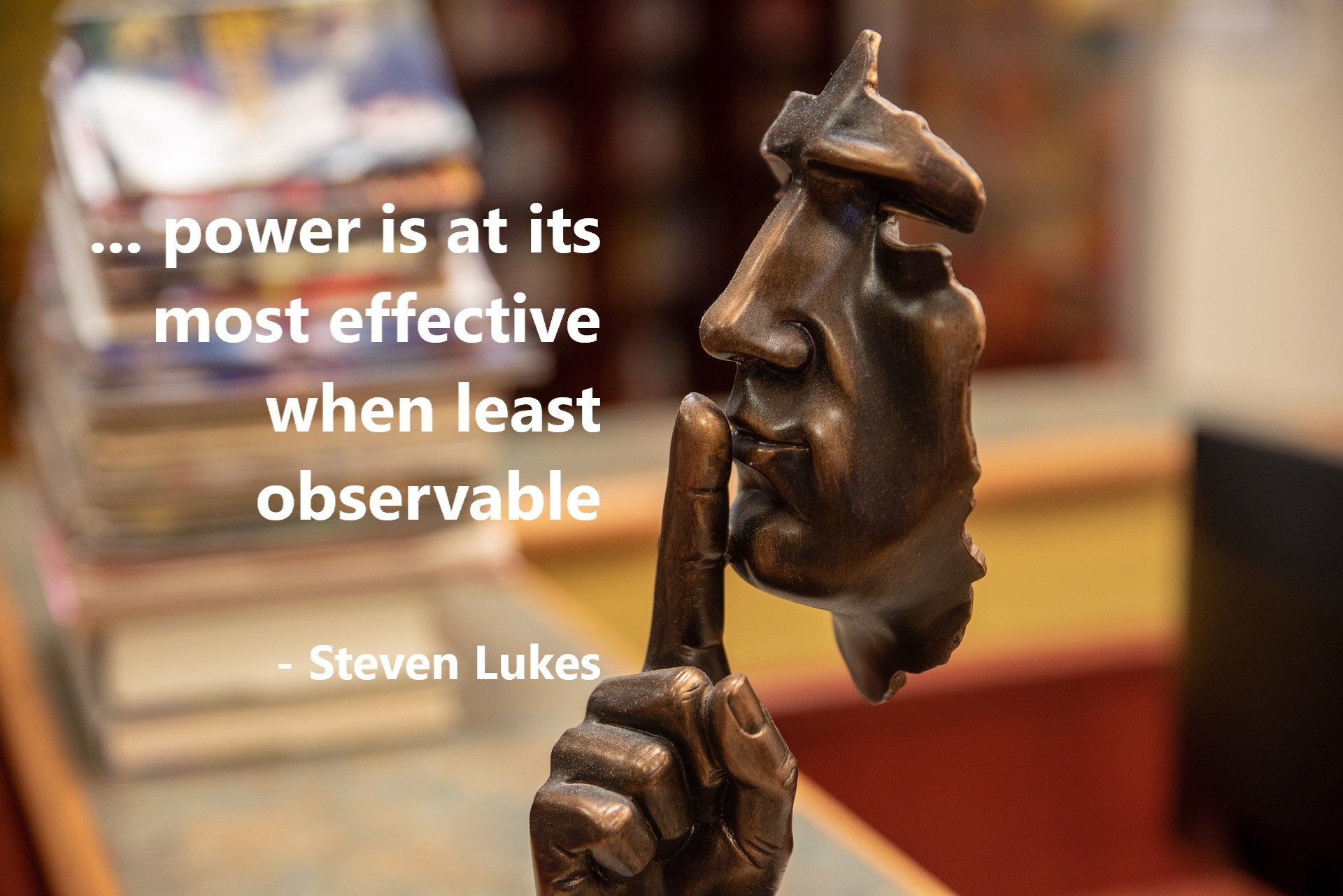Dimensions of power
Section audio
Steven Lukes developed a framework that identified three dimensions of power.[1]
- The first two dimensions consider power as it pertains to conflicting interests between parties.
- The third dimension explores how those with power can avoid clashes of interests by shaping others’ wants and desires.
Later, other scholars identified a fourth dimension that saw power as a web of relations that provides the scaffolding of societies.
The One-Dimensional View of Power
Under the first dimension, power is the ability to get someone to do what you want. Here, power is active in direct, observable conflicts. Our focus is on the behaviours people deploy in decision-making when different parties’ interests are in opposition.
The Two-Dimensional View of Power
Whereas power’s first dimension considers the ability of one party to secure the compliance of another when interests conflict, the second dimension considers how those with power suppress conflict.
That is, a group has power if it can limit the scope of what is debated, thereby confining decision-making to issues they deem safe. Parties may achieve this through various means.
- Coercion: You secure the compliance of others through threats of deprivation. For example, an employer may say, “Do this, or I will fire you.”
- Influence: You secure the compliance of others without resorting to threats. Instead, you convince others to comply through various means (e.g., making a persuasive argument).
- Authority: Others comply with you because they recognize your authority (e.g., a young child may obey their parents because the parents are in charge).
- Force: You secure the compliance of others by stripping from them the choice of non-compliance (e.g., the police may close off the road, forcing you to find another route home).
- Manipulation: You secure others’ compliance without their awareness (e.g., a company may withhold data about the negative side-effects of its products so that you buy them).
What the first and second dimensions of power have in common
With both the first and second dimensions of power, there exist conflicts of interests between parties. The first dimension resolves those differences through open conflict, the second by suppressing one side’s ability or willingness to engage in a public battle.
The third dimension considers the ability of those with power to avoid the need for conflict altogether.
The Three-Dimensional View of Power
The third dimension of power considers the ability to avoid conflict. Those with power can shape people’s perceptions of their situation and influence how they think and understand the world. Through such means, those with power can shape others’ preferences to the point they comply because they are incapable of imagining an alternative. They see compliance as natural.
For example, a business may promote the idea that a sign of good character is a willingness to work hard. Going above and beyond the call of duty is a virtue. The business rewards people who possess that virtue with promotions and career advancement.
Over time, a worker immersed in this environment may come to believe that hard work is a virtue. When the company asks that worker to work unpaid overtime on the weekend, the person may choose to do so willingly. They sacrifice their time for the company’s good not out of coercion but because they believe doing so is virtuous.
The company has shaped the worker’s beliefs and preferences to the point the worker adopts the company’s interests.

A Contentious Fourth Dimension of Power
Another scholar, Michel Foucault, wrote extensively on power. Some people view his perspective as a fourth dimension. Dr. Lukes, who conceptualized the first three dimensions, disagrees with this. That is why this section is titled a “contentious” fourth dimension. Foucault’s work is influential, however, and people categorize it as a fourth power dimension. This textbook, therefore, introduces it here briefly.
The first three dimensions view power as repressive. They explore how the interests of one party may prevail over another either through:
- Conflict
- Suppressing conflict, or
- Shaping preferences.
Foucault, conversely, viewed power as productive. Through power, civilizations create things.
One of the more critical things societies create are individuals or what Foucault called “subjects.” Society creates subjects by indoctrinating people into roles and beliefs, transferring cultural knowledge to them, and monitoring people’s behaviour and enforcing norms. Through these processes, we create doctors, teachers, mothers, fathers, and every other subject that plays a part in society.
Foucault argued power was active in “micro-practices,” or the daily activities of life. When you exchange money for coffee, you reinforce the power structures through which our society creates an economy. When you study to do well on an exam, you reinforce the power structures through which our society transfers knowledge. Society is a rich web of power relations; our daily actions serve to create and re-create these webs.[2][3]
Key Takeaways
- Scholars have classified power into four dimensions.
- One-dimensional power: The ability to get people to do something that you want through open conflict
- Two-dimensional power: The ability to get what you want through suppressing conflict and limiting the scope of debate
- Three-dimensional power: The ability to get what you want by influencing the preferences of others
- Four-dimensional power: The dense web of power networks through which societies organize themselves
The ability to get what you want from others through direct, open conflict
Obtaining what you want through suppressing conflict and limiting the scope of what is debated to issues you deem safe.
The ability to get what you want by influencing the preferences of others.
The dense web of power networks through which societies organize themselves.

